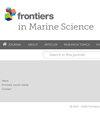Acoustic parameter variation and emission patterns in franciscana dolphin (Pontoporia blainvillei) clicking behavior at high frequency
IF 3
2区 生物学
Q1 MARINE & FRESHWATER BIOLOGY
引用次数: 0
Abstract
Franciscana dolphins are small odontocetes that produce narrow-band high-frequency echolocation clicks. Autonomous acoustic monitoring and field survey acoustic sampling were used to record franciscana dolphins in Ilha Grande Bay, Brazil. Clicking sequences were automatically detected and analyzed, and then manually classified into different types; acoustic parameters from individual clicks were extracted. A total of 12505 clicks were detected, 152 clicking sequences were analyzed, of which 43 were click trains and 109 were click packets. Considering all clicks, they occurred from 88.7 kHz to 250 kHz, with a mean peak frequency of 132.4 ± 6.8 kHz. Click trains were longer than click packets, with larger inter-click intervals and mean peak frequencies of 123.6 ± 16.4 kHz and 119.9 ± 15.0 kHz, respectively. Franciscana dolphins emitted different types of clicking sequences. The use of patterned clicks by franciscana dolphins may be an important communication feature at very high frequencies.白海豚高频咔哒声参数变化及发射模式
Franciscana海豚是一种小型齿形动物,能发出窄带高频回声定位声。采用自主声监测和野外调查相结合的方法对巴西格兰德湾的franciscana海豚进行了录音。对点击序列进行自动检测和分析,并进行人工分类;从单个咔哒声中提取声学参数。共检测到12505个点击,分析了152个点击序列,其中43个为点击列,109个为点击包。考虑到所有的咔哒声,它们发生在88.7 kHz到250 kHz之间,平均峰值频率为132.4±6.8 kHz。点击列比点击包更长,点击间隔更大,平均峰值频率分别为123.6±16.4 kHz和119.9±15.0 kHz。弗朗西斯卡纳海豚发出不同类型的点击序列。franciscana海豚在非常高的频率下使用有图案的咔哒声可能是一个重要的交流特征。
本文章由计算机程序翻译,如有差异,请以英文原文为准。
求助全文
约1分钟内获得全文
求助全文
来源期刊

Frontiers in Marine Science
Agricultural and Biological Sciences-Aquatic Science
CiteScore
5.10
自引率
16.20%
发文量
2443
审稿时长
14 weeks
期刊介绍:
Frontiers in Marine Science publishes rigorously peer-reviewed research that advances our understanding of all aspects of the environment, biology, ecosystem functioning and human interactions with the oceans. Field Chief Editor Carlos M. Duarte at King Abdullah University of Science and Technology Thuwal is supported by an outstanding Editorial Board of international researchers. This multidisciplinary open-access journal is at the forefront of disseminating and communicating scientific knowledge and impactful discoveries to researchers, academics, policy makers and the public worldwide.
With the human population predicted to reach 9 billion people by 2050, it is clear that traditional land resources will not suffice to meet the demand for food or energy, required to support high-quality livelihoods. As a result, the oceans are emerging as a source of untapped assets, with new innovative industries, such as aquaculture, marine biotechnology, marine energy and deep-sea mining growing rapidly under a new era characterized by rapid growth of a blue, ocean-based economy. The sustainability of the blue economy is closely dependent on our knowledge about how to mitigate the impacts of the multiple pressures on the ocean ecosystem associated with the increased scale and diversification of industry operations in the ocean and global human pressures on the environment. Therefore, Frontiers in Marine Science particularly welcomes the communication of research outcomes addressing ocean-based solutions for the emerging challenges, including improved forecasting and observational capacities, understanding biodiversity and ecosystem problems, locally and globally, effective management strategies to maintain ocean health, and an improved capacity to sustainably derive resources from the oceans.
 求助内容:
求助内容: 应助结果提醒方式:
应助结果提醒方式:


